 1984 Jeep Cherokee II (XJ) 3-door Dimensions, Size & Specs
1984 Jeep Cherokee II (XJ) 3-door Dimensions, Size & SpecsMeasurements of the 1984 Jeep Cherokee II 3-door, engineered for optimal performance and comfort
| Dimensions | |
|---|---|
| Length: | 4254-4288 mm167.5-168.8 in14.0-14.1 ft |
| Width: | 1720-1790 mm67.7-70.5 in5.6-5.9 ft |
| Height: | 1621-1630 mm63.8-64.2 in5.3-5.3 ft |
| Trunk Capacity: | 652-1011 liter23.0-35.7 cu ft |
| Trunk Capacity (Max): | 1315-2033 liter46.4-71.8 cu ft |
| Weight Specifications | |
| Curb Weight: | 1305-1630 kg2877-3594 lbs |
| Maximal permitted Weight: | 2087-2230 kg4601-4916 lbs |
| Tire Specifications | |
| Rims Size: |
|
| Tire Sizes: |
|
The Jeep Cherokee II (XJ) 3-door, produced between 1991 and 2001, represents a compact yet rugged SUV model that blends versatility with off-road capability. This generation continued the legacy of the original Cherokee, enhancing its utility with a shorter wheelbase and a three-door layout that appealed to buyers seeking a smaller, more maneuverable sport utility vehicle.
Measuring between 4254 mm and 4288 mm (167.4 to 168.9 inches) in length, and 1720 mm to 1790 mm (67.7 to 70.5 inches) in width, the Cherokee II offers a compact footprint ideal for urban driving and tight trail conditions alike. The vehicle's height ranges from 1621 mm to 1630 mm (63.8 to 64.2 inches), providing a commanding view of the road while maintaining a balanced center of gravity.
Curb weight varies from 1305 kg to 1630 kg (2877 to 3593 lbs), reflecting different trims and equipment packages available throughout the production years. The maximum weight capacity ranges between 2087 kg and 2230 kg (4602 to 4916 lbs), ensuring the SUV can handle heavy loads and off-road gear safely.
One of the Cherokee II’s practical highlights is its luggage capacity, offering between 652 and 1011 liters (23 to 35.7 cubic feet) of cargo space with rear seats upright. When rear seats are folded, this expands significantly to a range of 1315 to 2033 liters (46.4 to 71.8 cubic feet), showcasing the Cherokee’s flexibility for transporting larger items or outdoor gear.
The vehicle rides on 15-inch rims paired with various tire options designed to suit different driving needs, including sizes such as 215/75 R15, 225/70 R15, and 225/75 R15. These tire choices support both on-road comfort and off-road durability, reinforcing the Cherokee's reputation as a capable all-terrain vehicle.
Overall, the Jeep Cherokee II (XJ) 3-door stands out as a versatile compact SUV from the 90s, balancing size, cargo capacity, and weight with rugged styling and robust off-road performance. Its combination of manageable size and strong utility makes it a vehicle of enduring appeal among SUV enthusiasts and collectors.
Discover the standout features that make the 1984 Jeep Cherokee II 3-door a leader in its class
Have a question? Please check our knowledgebase first.
The Jeep Cherokee II (XJ) 3-door produced from 1991 to 2001 has a length ranging between 4254 mm and 4288 mm (167.4 to 168.9 inches). This compact length helped balance maneuverability with interior space, making it suitable for both urban driving and off-road adventures. The slight variance in length accounts for model year updates and possible aftermarket modifications.
The width of the Jeep Cherokee II (XJ) 3-door spans from 1720 mm to 1790 mm (67.7 to 70.5 inches). This width makes the vehicle stable on rough terrains, contributing to better handling and a comfortable cabin space for passengers. The broader width, compared to some compact SUVs of the era, provided a stable driving experience without compromising the ability to navigate tighter city streets.
The Jeep Cherokee II (XJ) 3-door stands between 1621 mm and 1630 mm tall (63.8 to 64.2 inches). This moderate height aids in providing sufficient headroom for passengers while maintaining a relatively low center of gravity. This balance improves on-road stability and enhances off-road capability by allowing better ground clearance and approach angles during challenging terrain navigation.
The curb weight of the Jeep Cherokee II (XJ) 3-door ranges from 1305 kg to 1630 kg (2877 to 3593 lbs), depending on trim and equipment. The maximum allowable weight, including cargo and passengers, ranges between 2087 kg and 2230 kg (4601 to 4916 lbs). These weights reflect the robust build of this SUV, balancing durability and durability with fuel efficiency considerations.
The Jeep Cherokee II (XJ) 3-door offers a luggage capacity ranging from 652 liters to 1011 liters (23 to 36 cubic feet) with the rear seats in place, providing ample storage for everyday needs, such as groceries or luggage for a small family. When the rear seats are folded down, the capacity expands significantly to between 1315 liters and 2033 liters (46 to 72 cubic feet), making it versatile for transporting larger items, camping gear, or bulky cargo.
The recommended rim size for the Jeep Cherokee II (XJ) 3-door is 15 inches in diameter. Tire sizes compatible with this generation are varied to fit different needs and terrain preferences, including 215/75 R15, 215/70 R15 S, 225/75 R15 S, 225/70 R15 S, 225/70 R15, 225/75 R15, and 225/70 R15 T. These sizes provide a good balance between off-road capability and on-road comfort, enhancing traction and stability.
Yes, the Jeep Cherokee II (XJ) 3-door fits comfortably into a standard residential garage. With a maximum length of around 4288 mm (168.9 inches or approximately 14 feet) and a height of approximately 1630 mm (64.2 inches or about 5.3 feet), it is compact enough to park in typical suburban garages which often accommodate vehicles up to 5 to 6 meters (16 to 20 feet) in length. Its width of up to 1790 mm (70.5 inches) also allows for parking with some space on the sides for opening doors safely.
The Cherokee II (XJ) 3-door marked a significant evolution over its predecessor, focusing on increased structural strength and improved space utilization despite having a relatively compact footprint. While the original Cherokee was larger and boxier, the XJ generation offered better aerodynamics and modern styling. Dimensionally, the XJ maintained similar length ranges but introduced wider track widths and more optimized interior layout, leading to better passenger comfort and cargo capacity options. Additionally, technological and safety features were upgraded, reflecting advances from the late '80s into the '90s.
Compared with other SUVs from the 1990s like the Toyota 4Runner, Ford Explorer, and Chevrolet Blazer, the Jeep Cherokee II (XJ) 3-door stands out with its true off-road heritage and durable body-on-frame construction. Size-wise, it was slightly more compact than some competitors, which helped it excel in more technical off-road conditions and urban maneuverability. It offered competitive cargo space given its 3-door configuration and provided a blend of rugged utility with an improving focus on driver comfort and daily usability. Its tire and rim options also reflected a capability-oriented setup typical of Jeep’s off-road legacy.
Potential buyers should consider the Jeep Cherokee II (XJ) 3-door for its classic styling, proven off-road capability, and manageable size. It balances practical cargo space with a compact footprint, making it versatile for both city use and rugged outdoor activities. Being produced from 1991 to 2001, this model brings a mix of older durability with updated features, appealing to enthusiasts who appreciate the legacy and robustness of classic Jeep SUVs. Additionally, its range in tires and rims supports customization depending on driving needs, while the reliable mechanical design ensures longevity with proper maintenance.
Discover similar sized cars.

| Production: | 1988-2001 |
|---|---|
| Model Year: | 1984 |
| Length: | 4240-4288 mm166.9-168.8 in |
| Width: | 1720-1790 mm67.7-70.5 in |
| Height: | 1621-1630 mm63.8-64.2 in |

| Production: | 2005-2013 |
|---|---|
| Model Year: | 2006 |
| Length: | 4315 mm169.9 in |
| Width: | 1815 mm71.5 in |
| Height: | 1685 mm66.3 in |

| Production: | 2016-present |
|---|---|
| Model Year: | 2017 |
| Length: | 4310 mm169.7 in |
| Width: | 1780 mm70.1 in |
| Height: | 1680 mm66.1 in |

| Production: | 2013-2017 |
|---|---|
| Model Year: | 2013 |
| Length: | 4273 mm168.2 in |
| Width: | 2057 mm81.0 in |
| Height: | 1650 mm65.0 in |

| Production: | 2007-2013 |
|---|---|
| Model Year: | 2008 |
| Length: | 4240 mm166.9 in |
| Width: | 1734 mm68.3 in |
| Height: | 1672 mm65.8 in |

| Production: | 2015-2021 |
|---|---|
| Model Year: | 2015 |
| Length: | 4315 mm169.9 in |
| Width: | 2000 mm78.7 in |
| Height: | 1695 mm66.7 in |

| Production: | 2011-2015 |
|---|---|
| Model Year: | 2012 |
| Length: | 4315 mm169.9 in |
| Width: | 1822 mm71.7 in |
| Height: | 1690 mm66.5 in |
